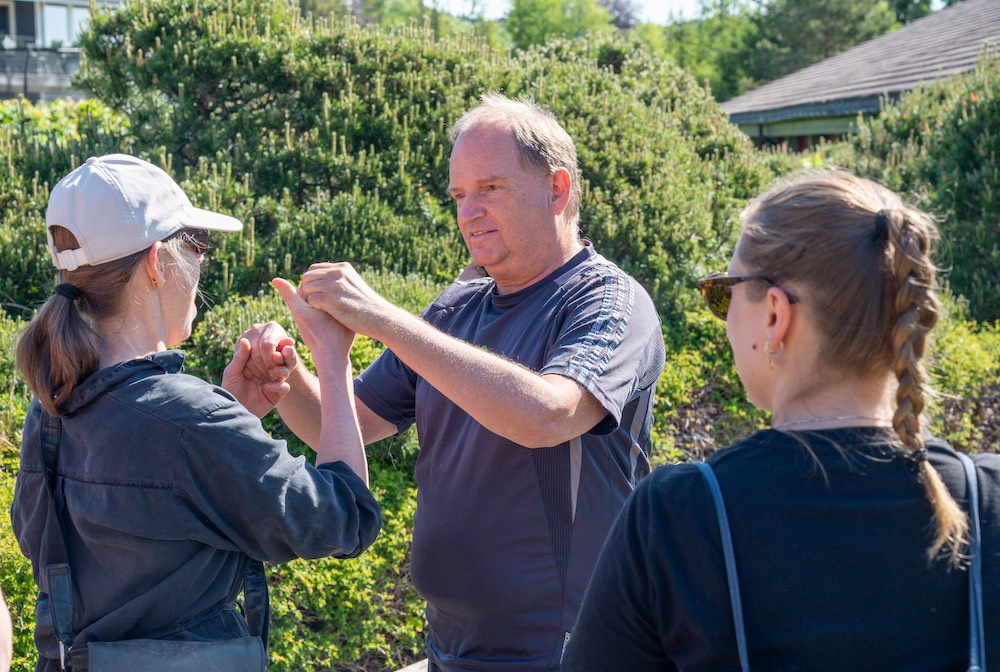- Deafblindness
- Syn
- Hearing
- Mobility
- Communication
- ICT
- Research projects
- Publications
- Conferences and webinars
- Video archive
Communication for people with combined visual and hearing impairment/deafblindness

Communication for people with combined visual and hearing impairment/deafblindness varies from person to person. The form of communication, the need for distance to the conversation partner and lighting conditions all vary. A combination of different forms of communication is often used.
Eikholt's course offerings
When both vision and hearing are impaired and gradually change, this can lead to practical and emotional adjustments. Both you and your loved ones may need to learn new methods and strategies to communicate better in daily life. There are many forms of communication and they can also change over time.
Opportunities in communication
Assistive listening devices
For many people, various hearing aids are a great help. These include hearing aids, CI (Cochlear Implant), microphones, streamers, conversation amplifiers, etc.
Font/point
PCs, iPads and iPhones combined with customised writing/reading lists with Braille adapted to the individual user are a functional aid for many visually and hearing impaired people.
Norwegian with sign support (NMT)
Norwegian with sign support is Norwegian spoken language supported by signs borrowed from Norwegian sign language. It is used by Norwegian speakers to support lipreading.
Hand alphabet/spelled communication
The choice of hand alphabet is individual, but is adapted to the time, place and conversation partner. The hand alphabets are used in combination with signs or speech and often to spell out names, place names or difficult words and expressions that cannot be understood. The two-handed alphabet is widely used among older deaf people and among people with combined visual and hearing impairments. A combination of Norwegian and international one-handed alphabet is used by young deaf people. The English one-handed alphabet is not widely used in Norway today, but was common among primarily Norwegian-speaking visually and hearing impaired people in the past.
Sign language
Norwegian Sign Language is a genuine Norwegian language used by thousands of deaf and hearing people as a first language. Sign language has its own grammar and modes of expression that differ from Norwegian. The language is gestural-visual, meaning that sign language expressions are based on the use of hands, facial expressions and body posture and are perceived through vision.
Sign language in a restricted sign room
For people with the eye disease RP, including people with Usher, restricted sign space may be relevant. This means that the signs are made smaller and closer to the face so that signs, facial expressions and facial expressions can be read more easily at the same time.
Tactile sign language
Tactile sign language is used if the recipient cannot perceive sign language through sight. For some, it is only relevant in certain situations, such as in the dark or when the distance between the speakers is too short to see the sign language. The speaker has their hands under the hands of the other person.
Haptic communication
A tactile sign/touch system used to supplement spoken or drawn words in parallel with language. The back, shoulder, hand, knee or foot are often used as the point of articulation. Yes/no/what/wait, table position (who sits where), height, quantity, direction and laughter are examples of what can be described using haptic communication.
General tips for people with good hearing and vision
Distance
Let the person with visual and hearing impairment/deafblindness decide the distance between you. Wait to start talking until you have been given the go-ahead.
Lily
You need good light to be able to read lip and facial movements. Position yourself so that the light falls on your face. Never stand with the light at your back, as this can cause glare for those with poor hearing and vision.
Sound environment
A lot of background noise makes it more difficult to understand speech, so minimise unwanted noise if possible. Remember that there can be a lot of noise in the waiting room, at the café or out on the street. People with hearing impairment find it harder to understand speech there than they do in quiet surroundings. It is also difficult to understand speech in rooms with a lot of reverberation, such as stairwells, corridors, etc.
Speak Clearly
Speak clearly at a moderate speed. Using natural signs, facial expressions, gestures and hand signals can help. Don't be afraid to try!
Interpreter
Speak directly to the person with visual and hearing impairment/deafblindness. The interpreter/companion will work with both of you.
Technical aids
Many people with deafblindness have technical aids that can facilitate communication. For example, microphones can be used to make speech easier to understand, or a mobile phone, possibly with a Braille display, can be used to send short messages. Let the person with visual and hearing impairment/deafblindness show how it can be used.
Do you have any questions?
Get in touch with us. Contact us - Eikholt
